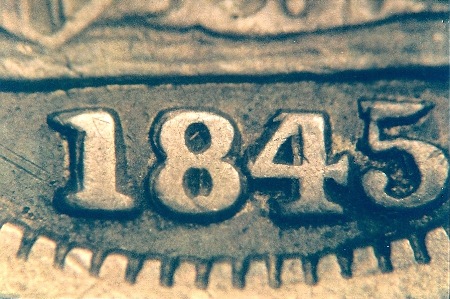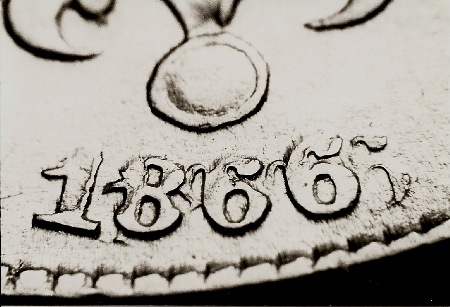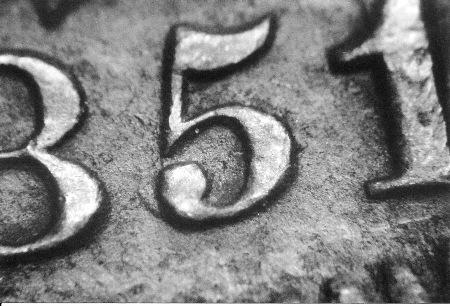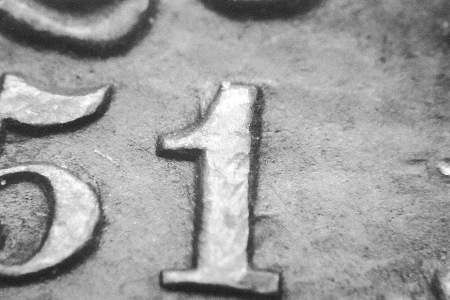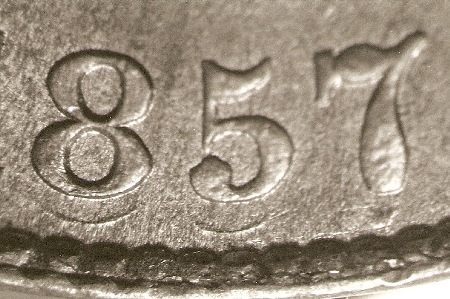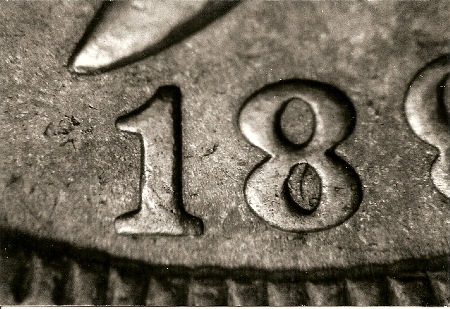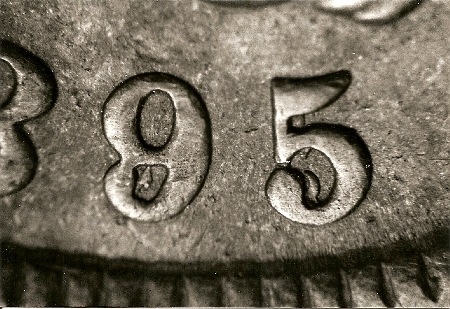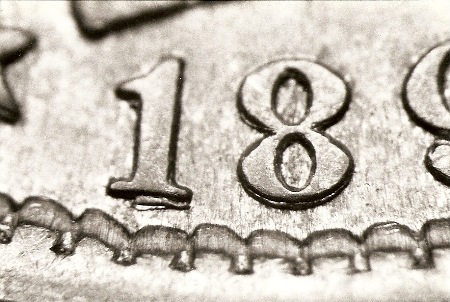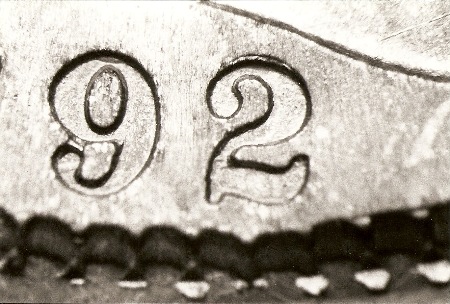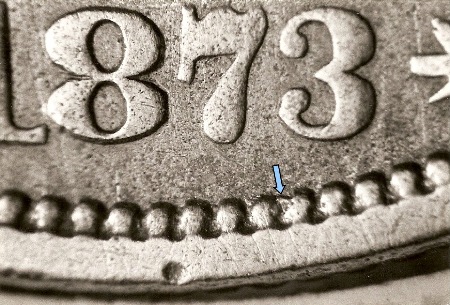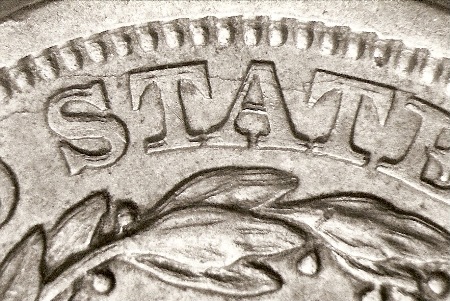


 |
 |
 |
 |
 |
 |
 |
 |
 |
 |
 |
 |
 |
 |
 |
 |
 |
 |
 |
 |
 |
 |
 |
 |
During the earliest days at the U.S. Mint, from 1792 through 1836, the Mint did not have any reduction lathes to transfer the coin’s design from a galvano to a master hub. Rather, a Mint engraver carved the central design for a coin directly into the face of the master die. The design elements around the rim such as the motto, the date, and/or the stars did not appear on the master die. When completed, the master die was placed in a hubbing press where it was used to make working hubs. Like the master die, these working hubs only contained the central design for the coins. The working hubs were then used in the hubbing press to make the working dies which at this point contained only the central design elements. The reason that the master die only contained the central design elements was the fact that the hubbing press that was used during this period of time was a “screw press.” With this type of press it wasn’t possible to apply enough pressure during the hubbing process to transfer the design elements nearest to the rim. As a result, the design elements nearest to the rim were hand punched directly into the working dies. Because the design elements near the rim were hand punched into the working dies, numerous varieties involving inconsistent spacing of the letters, stars, or digits in the date resulted. It also allowed for the possibility of differences in the letters or numerals to appear on the working dies within the same year. These differences were sometimes design differences (serifs vs. no serifs) and sometimes they were size differences (Large 4 vs. Small 4). For example, in 1828 Half Cents coins were produced with either 13 stars around the rim on the obverse or just 12 stars around the rim. The 1812 Large Cents come with either a Large Date or a Small Date. The same is true for the 1819 Large cents. The 1803 Half Dimes were produced with either a “Large 8” in the date or a “Small 8 in the date. The 1820 quarters can be found with a “Large 0” or a “Small 0” in the date. These are just a few examples of what I am talking about. For more examples, just grab a copy of A Guide Book of United States Coins (a.k.a. The Red Book) and look through the information for the various denominations struck during this time period. Walter Breen’s Complete Encyclopedia of U.S. and Colonial Coins is another great reference to turn to for examples of the die varieties produced during this time period. Numerous specialty books can be found devoted to a particular coinage issue and these also illustrate the die varieties that can be found for the respective coinage issue covered in the book.
For those of us interested in collecting date punching varieties, we are in luck. For all of the design elements around the rim it frequently required more than one blow with a mallet and a hand-held punch to leave a satisfactory image of that design element in the die. For the date the punch was either a punch containing a single digit, or it was sometimes a logo punch containing more than one digit (sometimes the entire date). Like other design elements around the rim, the digits of the date required more than one blow of the mallet to leave a satisfactory impression in the die. If there was some misalignment of the hand-held punch and the image already in the die from the previous punch, the result was one or more doubled digits in the date.
This 1845 Half Dime is listed in the Wexler Die Variety Files as 1845 ½ 10¢ WRPD-001. It shows strong doubling spread to the east on all of the digits in the date. The fact that all of the digits are doubled in the same manner suggests that a logo punch containing all of the digits in the date was used to punch the date into the die.
This 1847 Large Cent listed as WRPD-006 which was submitted by Robert Pelletier shows strong doubling on the 1 and lesser doubling on the 8.
This dramatic repunched date on an 1866 Shield Nickel also suggests the use of a logo punch to punch the date into the working die. This one is listed as 1866 5¢ WRPD-001. It is also listed in The Cherrypickers’ Guide to Rare Die Varieties as FS-05-1866-302 (001.1).
These two photos show doubling to the 5 and the second 1 in the date of an 1851 Large Cent that we have listed as 1851 1¢ WRPD-001 thanks to Tony Russo. The different directions and spreads to the doubled digits indicates that punches with single digits were used to punch the date into the working die rather than a logo punch. In 1836 the Mint introduced the French Portrait Lathe. At this point the Mint started using galvanos to produce the designs that would appear on coins. One arm on the lathe would trace out the design on the galvano while a second arm reduced the image and carved it out onto the face of a master hub. In 1867 the Hill Reducing Lathe replaced the French Portrait Lathe and in 1907 the French Portrait Lathe replaced the Hill Reducing Lathe. All of these lathes performed the same function. With the introduction of the Indian Head cents, the Mint began placing the letters around the rim of the obverse onto the master die. To avoid the mistakes and inconsistencies seen in prior coin series when those letters were hand-punched into the working dies, a single circular punch was used which contained the entire arrangement of letters around the rim so that they could all be impressed at the same time. At this point in time the date did not appear on the master die and was still hand-punched into the individual working dies. This was done so that the master die could be used over a period of more than one year.
This 1857 Flying Eagle cent shows dramatic doubling on the 8, 5, and 7 in the date. It is listed as 1857 1¢ WRPD-001 and was submitted by Kevin Flynn. It is also listed in The Cherrypickers’ Guide to Rare Die Varieties as FS-01-1857-301 (001.5). Richard Snow lists this one as Snow 11.
These two photos show the doubling on the 8,9, and 5 of an 1895 Indian Head cent repunched date variety that we have listed as 1895 1¢ WRPD-001 and it is in our files thanks to Rodney D. Zabreznik. It is listed in The Cherrypickers’ Guide to Rare Die Varieties as FS-01-1895-301 (011.3) and by Richard Snow as Snow 1.
Gregory Thurman submitted this 1901 Indian Head cent that we have listed as 1901 1¢ WRPD-001. It shows doubling to the lower right 9 and 0 in the date. Around 1886 the Mint began placing the letters around the rim of the Indian cent onto the galvano. When the Janvier Reduction Lathe was introduced in 1907, the first two digits of the date began to appear on the galvano and thus on the master hub. In 1893 the Mint switched from screw press to hydraulic hubbing presses eliminating the problems that they had in transferring the design elements near the rim during the hubbing process. Throughout this entire time the date continued to be punched into the individual working dies. This kept open the possibility that repunched dates would occur and Murphy’s Law stepped in. Since the repunched date errors could occur, they did much to the delight of die variety collectors today.
Repunched digits (189) spread to the north show on this 1892 Barber Quarter that we have listed as 1892 25¢ WRPD-001. The 2 does not show any evidence of being repunched. Die variety collectors get a bonus with this variety. In addition to the repunched date, this die also has a QUADRUPLED obverse die! The "doubled die" is listed as 1892 25¢ WDDO-001.
If you look carefully, you can see the quadrupled images on the letters of TRUST, especially on the upper S. This is 1892 25¢ WDDO-001 and the quadrupling shows on all of the stars, the letters of IN GOD WE TRUST, and the outer ribbon. Anyone fortunate enough to find one of these gets two different die varieties, a repunched date (WRPD-001) and a quadrupled die, all on the same coin.
In the two photos above we see another repunched date on an 1892 Barber Quarter. This one also shows a repunching spread to the north on the 1 and 8, but the 2 is clearly repunched to the south. This repunched date is listed in the files as 1892 25¢ WRPD-002. Like WRPD-001, the obverse is also a doubled die.
Here we see some of the doubled die doubling on the 1892 Barber Quarter repunched date variety listed as 1892 25¢ WRPD-002. A nice Class II spread towards the center is seen on all of the stars, the bottom and left side of the ribbon, the letters of IN GOD WE TRUST, and very slightly on the outside of the bonnet and the profile. The doubled die doubling is listed in the doubled die files as 1892 25¢ WDDO-003. Once again we have a die that has two different die variety types - a nice repunched date and a doubled die. When the Lincoln cent was introduced in 1909, the Mint started placing the last two digits of the date into the master die, rather than punching them into the individual working dies. For years die variety specialists thought that the last two digits of the date were punched into the master die, however, compelling research by Robert H. Neff has shown that the last two digits were engraved into the master dies and were not hand-punched. This change effectively eliminated the repunched date error.
Another die variety type resulted during the time period in which the date was being hand-punched into the working dies. These varieties have come to be known as Misplaced Date (MPD) varieties. They are a form of repunched date, but this group features digits that are punched a significant distance from where they were supposed to be punched. The errant digits usually ended up in the denticles around the rim. Sometimes, however, these misplaced digits ended up being punched into parts of the lower central design such as the lower bust on the Indian Head cents.
Here we see the top of an 8 that was punched into the denticles below the normal first 8 of this 1887 Indian Head cent. It is listed in the Wexler Die Variety Files as 1887 1¢ WMPD-001. In his book on misplaced date varieties Kevin Flynn lists this one as MPD-002. Specialists still do not agree on a reason for these very widely misplaced digits. Kevin Flynn wrote a book about the misplaced date varieties entitled Two Dates Are Better Than One – A Collector’s Guide to Misplaced Dates. It is the only reference that I am aware of that deals exclusively with the misplaced date varieties. In that book numerous hobby specialists offer their thoughts as to why the digits in the date are so widely misplaced on these varieties. All MPD varieties known at the time the book was published for all denominations of U.S. coins are illustrated in this reference. It is an absolute must for your numismatic library, if you do not yet own a copy.
This 1873 Liberty Seated Dime is listed in the Wexler Die Variety Files as 1873 10¢ WMPD-001. It shows the top of an extra 3 punched into the denticles. Flynn lists this variety as MPD-001. Like some of the repunched date varieties, it has a bonus attached to it - a very strong doubled die obverse.
Extremely strong doubling shows on the shield of the 1873 Liberty Seated dime that we have listed as 1873 10¢ WMPD-001. The doubled die is listed in the Wexler Files as 1873 10¢ WDDO-001. I would suspect that this variety would get the bulk of its value from the doubled die doubling. In this case the misplaced date variety adds a little icing to the cake!
During the era in which the dates were hand-punched into the working dies another popular die variety type resulted. That variety type is known as the overdate (OVD). Overdates occur when two different dates are punched into the same working die. There is an abundance of overdate varieties known for the years in which the dates were hand-punched into the working dies. The existence of these varieties most likely represents an effort on the part of the Mint to not waste leftover working dies at the end of a production year. Rather than throw out a perfectly good die, it was more economical to simply repunch the last digit or the last two digits in the date so that it could be used for the next production year’s coinage.
This 1849 Large Cent might at first glance appear to have a repunched date variety with doubling on the 9. However, closer examination indicates that the underlying image can not be a 9. The upper part of the doubled image curves sharply back towards the 9 which is consistent with an underlying 8 rather than a 9 making this a 9/8 overdate variety. It is listed in the Wexler Files as 1849 1¢ WOVD-001. Hold on! It's bonus time once again!!!
The reverse of the overdate variety listed as 1849 1¢ WOVD-001 is a strong Class II doubled die variety. A spread towards the center shows on the letters of UNITED STATES OF AMERICA, the upper wreath, and the letters of ONE CENT. The doubled die variety is listed as 1849 1¢ WDDR-001. The overdate variety is the one variety type that carried over after the Mint ceased the practice of hand-punching the digits of the date into the working dies in 1909. Several overdates are known for the years after 1909, but unlike the overdate varieties that were produced prior to 1909, these are not punching varieties. Rather, they are Class III doubled die varieties produced when a working die with one date received an impression from a working hub with a different date. Because of this, they do not carry OVD die numbers in the Wexler Files. They are listed with the appropriate doubled die numbers. Since all of the post-1909 overdate varieties were produced on dies set in the time frame of the World Wars, speculation has it that they too may have been produced intentionally. The theory suggests that since these were difficult times, the varieties may be the result of a money saving effort on the part of the Mint. In each case there may have been a leftover die from that year and rather than waste an otherwise good die, the die was rehubbed with a hub bearing the date of the next year. The post-1909 overdate doubled die varieties include the 1918/7-D Buffalo nickel, the 1918/7-S Standing Liberty Quarter, the 1942/1 and 1942/1-D Mercury Dimes, and the 1943/2-P Jefferson Nickel. We may never know for sure if they were accidental or intentional, but there is one thing that we do know for sure. They are extremely popular and very valuable.
Here we see the 1942/1 P-Mint Mercury Dime listed as 1942 10¢ WDDO-001. It is a Class III doubled die variety on which a working die with the 1941 date was rehubbed with a working hub bearing the 1942 date giving us the very popular 1942/1 overdate variety.
This is the 1943-P Jefferson nickel listed as 1943-P 5¢ WDDO-001 in the Wexler Die Variety Files. It was first discovered by Delma K. Romines and is clearly a 3/2 overdate. Most likely a leftover working die from 1942 was rehubbed by a working hub for 1943 so as not to waste an otherwise good working die.
As you can see, the practice of punching the date into the working dies during the late 18th century, the 19th century, and the beginning of the 20th century, left us with three very desirable die variety types to collect. Of the three types, the overdates are the most popular and the most sought after. As a result, they bring the greatest premiums. The repunched dates are quite popular and the misplaced dates are the “new kids on the block.” They too are rapidly gaining in popularity. My guess is that your greatest chance for success in finding these varieties at coin shows (cherrypicking them) would be in the MPD arena since they are relatively new and there probably aren’t a lot of collectors out there looking for them just yet. The knowledgeable collectors are. Don’t let them find them all before you get there! | ||



